Essay: Assessing Chicago's City-Wide Sustainability Plan (GEOP830)
VerifiedAdded on 2023/06/07
|10
|2486
|285
Essay
AI Summary
This essay provides a critical assessment of Chicago's city-wide sustainability plan, focusing on its alignment with the criteria established by UN Habitat. The analysis delves into various aspects of the plan, including the development of renewable energy sources, the city's progress toward carbon neutrality, and the implementation of green infrastructure initiatives. It also examines the strategies employed to improve eco-efficiency, promote sustainable transport options, and address issues related to water systems and urban development. The essay evaluates the effectiveness of the Chicago plan in meeting its sustainability goals, drawing on the 2015 Sustainable Chicago action agenda. It also includes a critical evaluation of the plans related to economic development, transportation, water and wastewater, energy efficiency, waste management, climate change, and the creation of parks and open spaces. The assessment highlights the strengths and weaknesses of the plan, providing a comprehensive overview of Chicago's efforts to become a more sustainable urban environment.
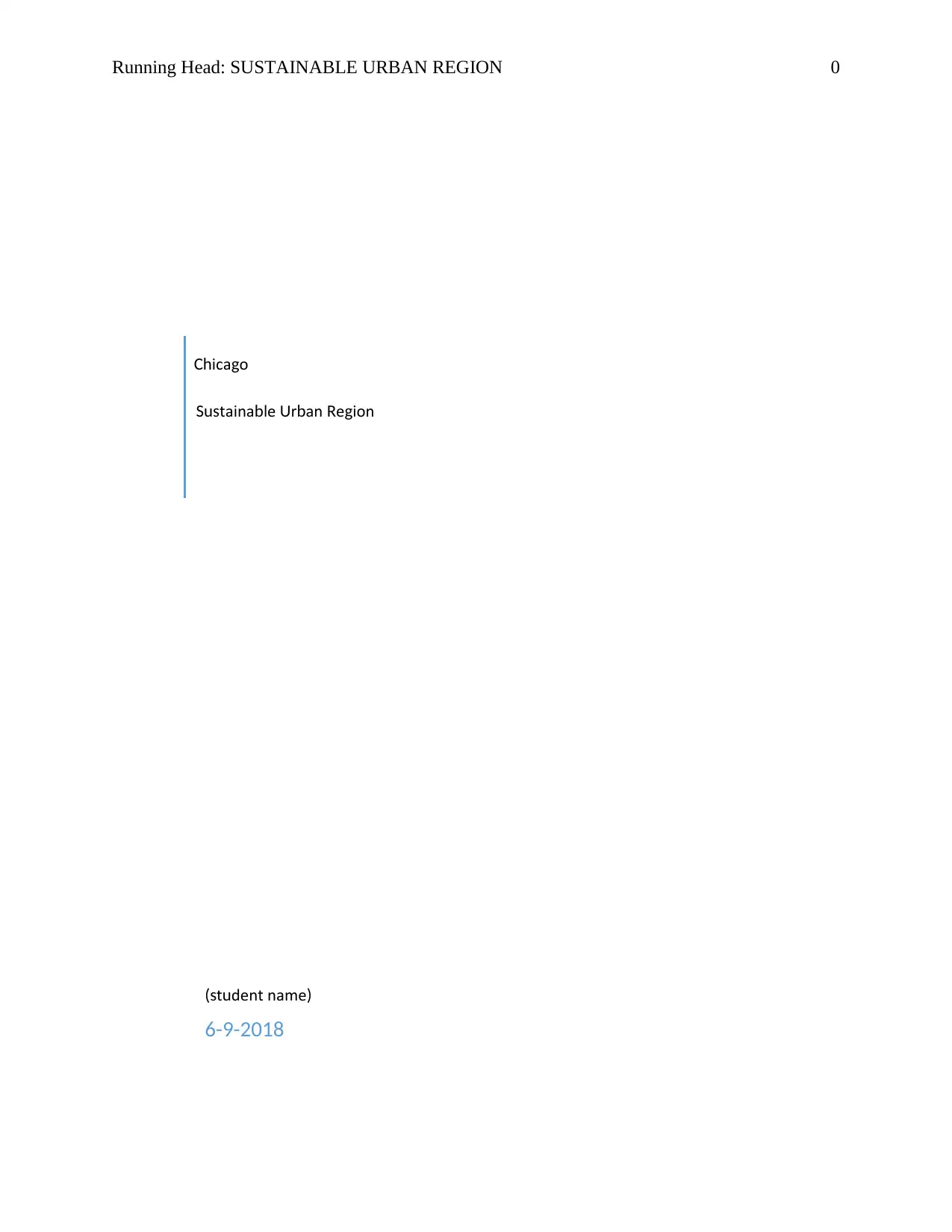
Running Head: SUSTAINABLE URBAN REGION 0
ica oCh g
taina le r an e ionSus b U b R g
t dent name(s u )
6-9-2018
ica oCh g
taina le r an e ionSus b U b R g
t dent name(s u )
6-9-2018
Paraphrase This Document
Need a fresh take? Get an instant paraphrase of this document with our AI Paraphraser

SUSTAINABLE URBAN REGION 1
Executive summary
For the discussion of sustainability plans city wide, the city of Chicago was selected for which
sustainability plans were to be assessed on the bases of criteria provided by UN habitat 2009.
Sustainable Chicago action agenda report was studied for this concern and there were eight
major plans provided in this report which were fulfilling most of the criteria planned for the
assessment.
Eight characteristics on which the critical analysis of Chicago sustainable plan would be done
are: developing renewable energy, Developing locally distributed power, striving for carbon-
neutral cities, water systems , Increasing photosynthetic spaces as a part of the green
infrastructure, increase the sense of place, Improving the eco-efficiency, Developing sustainable
transport, developing cities without slums.
For these eight criteria’s, while critical analysis, seven plans for sustainable city were: economic
development and job creation; transportation options; water and wastewater; energy efficiency
and clean energy; waste & recycling; climate change; parks, open space, and healthy food.
Executive summary
For the discussion of sustainability plans city wide, the city of Chicago was selected for which
sustainability plans were to be assessed on the bases of criteria provided by UN habitat 2009.
Sustainable Chicago action agenda report was studied for this concern and there were eight
major plans provided in this report which were fulfilling most of the criteria planned for the
assessment.
Eight characteristics on which the critical analysis of Chicago sustainable plan would be done
are: developing renewable energy, Developing locally distributed power, striving for carbon-
neutral cities, water systems , Increasing photosynthetic spaces as a part of the green
infrastructure, increase the sense of place, Improving the eco-efficiency, Developing sustainable
transport, developing cities without slums.
For these eight criteria’s, while critical analysis, seven plans for sustainable city were: economic
development and job creation; transportation options; water and wastewater; energy efficiency
and clean energy; waste & recycling; climate change; parks, open space, and healthy food.
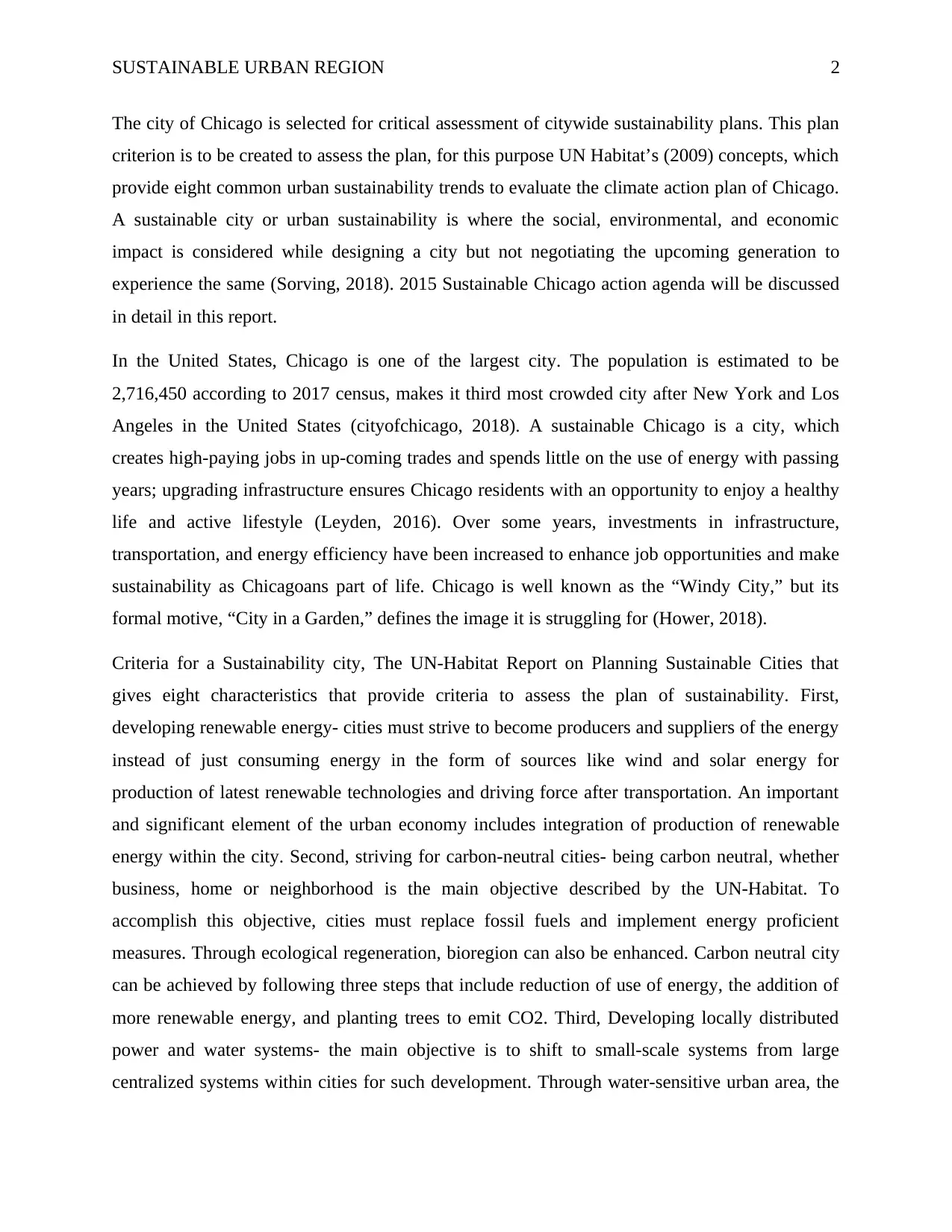
SUSTAINABLE URBAN REGION 2
The city of Chicago is selected for critical assessment of citywide sustainability plans. This plan
criterion is to be created to assess the plan, for this purpose UN Habitat’s (2009) concepts, which
provide eight common urban sustainability trends to evaluate the climate action plan of Chicago.
A sustainable city or urban sustainability is where the social, environmental, and economic
impact is considered while designing a city but not negotiating the upcoming generation to
experience the same (Sorving, 2018). 2015 Sustainable Chicago action agenda will be discussed
in detail in this report.
In the United States, Chicago is one of the largest city. The population is estimated to be
2,716,450 according to 2017 census, makes it third most crowded city after New York and Los
Angeles in the United States (cityofchicago, 2018). A sustainable Chicago is a city, which
creates high-paying jobs in up-coming trades and spends little on the use of energy with passing
years; upgrading infrastructure ensures Chicago residents with an opportunity to enjoy a healthy
life and active lifestyle (Leyden, 2016). Over some years, investments in infrastructure,
transportation, and energy efficiency have been increased to enhance job opportunities and make
sustainability as Chicagoans part of life. Chicago is well known as the “Windy City,” but its
formal motive, “City in a Garden,” defines the image it is struggling for (Hower, 2018).
Criteria for a Sustainability city, The UN-Habitat Report on Planning Sustainable Cities that
gives eight characteristics that provide criteria to assess the plan of sustainability. First,
developing renewable energy- cities must strive to become producers and suppliers of the energy
instead of just consuming energy in the form of sources like wind and solar energy for
production of latest renewable technologies and driving force after transportation. An important
and significant element of the urban economy includes integration of production of renewable
energy within the city. Second, striving for carbon-neutral cities- being carbon neutral, whether
business, home or neighborhood is the main objective described by the UN-Habitat. To
accomplish this objective, cities must replace fossil fuels and implement energy proficient
measures. Through ecological regeneration, bioregion can also be enhanced. Carbon neutral city
can be achieved by following three steps that include reduction of use of energy, the addition of
more renewable energy, and planting trees to emit CO2. Third, Developing locally distributed
power and water systems- the main objective is to shift to small-scale systems from large
centralized systems within cities for such development. Through water-sensitive urban area, the
The city of Chicago is selected for critical assessment of citywide sustainability plans. This plan
criterion is to be created to assess the plan, for this purpose UN Habitat’s (2009) concepts, which
provide eight common urban sustainability trends to evaluate the climate action plan of Chicago.
A sustainable city or urban sustainability is where the social, environmental, and economic
impact is considered while designing a city but not negotiating the upcoming generation to
experience the same (Sorving, 2018). 2015 Sustainable Chicago action agenda will be discussed
in detail in this report.
In the United States, Chicago is one of the largest city. The population is estimated to be
2,716,450 according to 2017 census, makes it third most crowded city after New York and Los
Angeles in the United States (cityofchicago, 2018). A sustainable Chicago is a city, which
creates high-paying jobs in up-coming trades and spends little on the use of energy with passing
years; upgrading infrastructure ensures Chicago residents with an opportunity to enjoy a healthy
life and active lifestyle (Leyden, 2016). Over some years, investments in infrastructure,
transportation, and energy efficiency have been increased to enhance job opportunities and make
sustainability as Chicagoans part of life. Chicago is well known as the “Windy City,” but its
formal motive, “City in a Garden,” defines the image it is struggling for (Hower, 2018).
Criteria for a Sustainability city, The UN-Habitat Report on Planning Sustainable Cities that
gives eight characteristics that provide criteria to assess the plan of sustainability. First,
developing renewable energy- cities must strive to become producers and suppliers of the energy
instead of just consuming energy in the form of sources like wind and solar energy for
production of latest renewable technologies and driving force after transportation. An important
and significant element of the urban economy includes integration of production of renewable
energy within the city. Second, striving for carbon-neutral cities- being carbon neutral, whether
business, home or neighborhood is the main objective described by the UN-Habitat. To
accomplish this objective, cities must replace fossil fuels and implement energy proficient
measures. Through ecological regeneration, bioregion can also be enhanced. Carbon neutral city
can be achieved by following three steps that include reduction of use of energy, the addition of
more renewable energy, and planting trees to emit CO2. Third, Developing locally distributed
power and water systems- the main objective is to shift to small-scale systems from large
centralized systems within cities for such development. Through water-sensitive urban area, the
⊘ This is a preview!⊘
Do you want full access?
Subscribe today to unlock all pages.

Trusted by 1+ million students worldwide
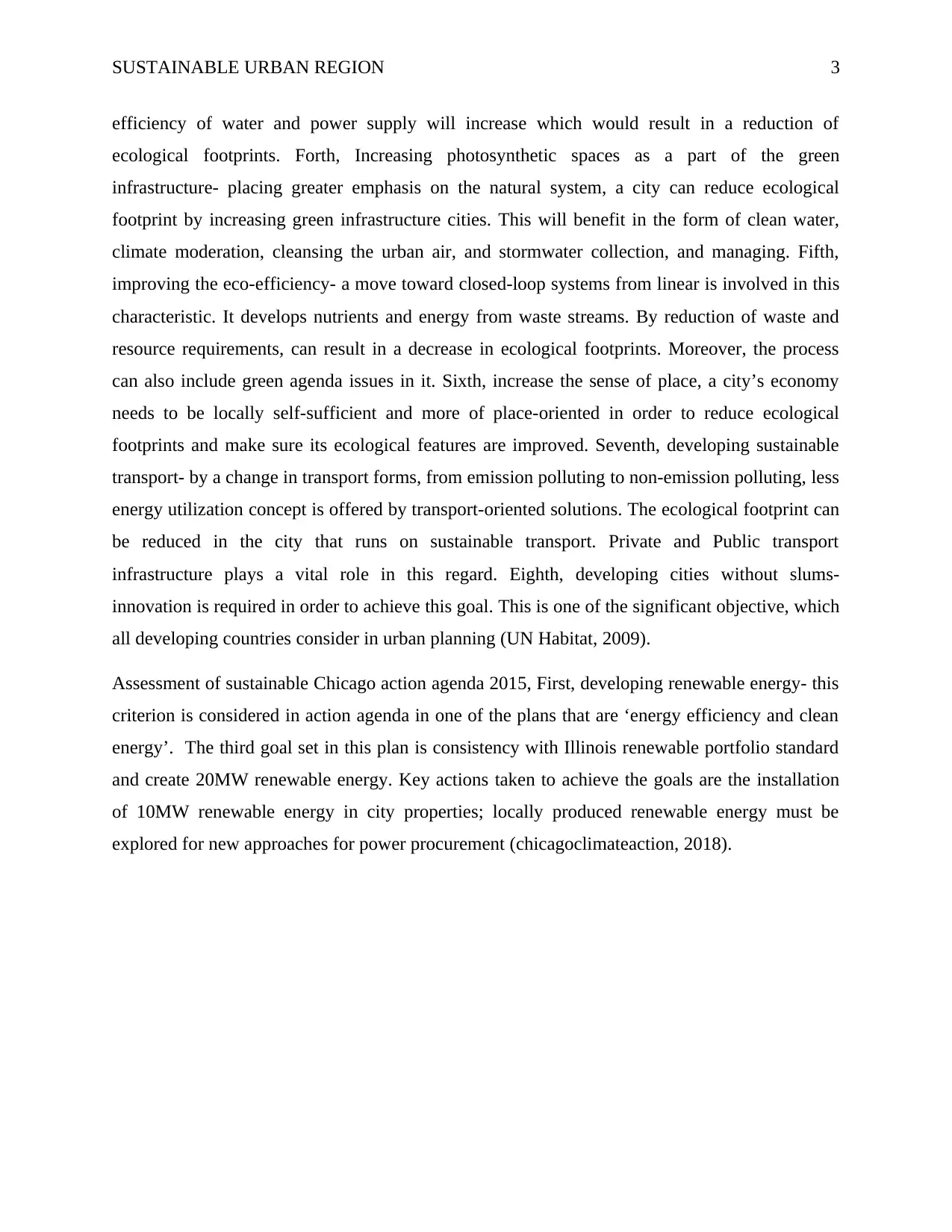
SUSTAINABLE URBAN REGION 3
efficiency of water and power supply will increase which would result in a reduction of
ecological footprints. Forth, Increasing photosynthetic spaces as a part of the green
infrastructure- placing greater emphasis on the natural system, a city can reduce ecological
footprint by increasing green infrastructure cities. This will benefit in the form of clean water,
climate moderation, cleansing the urban air, and stormwater collection, and managing. Fifth,
improving the eco-efficiency- a move toward closed-loop systems from linear is involved in this
characteristic. It develops nutrients and energy from waste streams. By reduction of waste and
resource requirements, can result in a decrease in ecological footprints. Moreover, the process
can also include green agenda issues in it. Sixth, increase the sense of place, a city’s economy
needs to be locally self-sufficient and more of place-oriented in order to reduce ecological
footprints and make sure its ecological features are improved. Seventh, developing sustainable
transport- by a change in transport forms, from emission polluting to non-emission polluting, less
energy utilization concept is offered by transport-oriented solutions. The ecological footprint can
be reduced in the city that runs on sustainable transport. Private and Public transport
infrastructure plays a vital role in this regard. Eighth, developing cities without slums-
innovation is required in order to achieve this goal. This is one of the significant objective, which
all developing countries consider in urban planning (UN Habitat, 2009).
Assessment of sustainable Chicago action agenda 2015, First, developing renewable energy- this
criterion is considered in action agenda in one of the plans that are ‘energy efficiency and clean
energy’. The third goal set in this plan is consistency with Illinois renewable portfolio standard
and create 20MW renewable energy. Key actions taken to achieve the goals are the installation
of 10MW renewable energy in city properties; locally produced renewable energy must be
explored for new approaches for power procurement (chicagoclimateaction, 2018).
efficiency of water and power supply will increase which would result in a reduction of
ecological footprints. Forth, Increasing photosynthetic spaces as a part of the green
infrastructure- placing greater emphasis on the natural system, a city can reduce ecological
footprint by increasing green infrastructure cities. This will benefit in the form of clean water,
climate moderation, cleansing the urban air, and stormwater collection, and managing. Fifth,
improving the eco-efficiency- a move toward closed-loop systems from linear is involved in this
characteristic. It develops nutrients and energy from waste streams. By reduction of waste and
resource requirements, can result in a decrease in ecological footprints. Moreover, the process
can also include green agenda issues in it. Sixth, increase the sense of place, a city’s economy
needs to be locally self-sufficient and more of place-oriented in order to reduce ecological
footprints and make sure its ecological features are improved. Seventh, developing sustainable
transport- by a change in transport forms, from emission polluting to non-emission polluting, less
energy utilization concept is offered by transport-oriented solutions. The ecological footprint can
be reduced in the city that runs on sustainable transport. Private and Public transport
infrastructure plays a vital role in this regard. Eighth, developing cities without slums-
innovation is required in order to achieve this goal. This is one of the significant objective, which
all developing countries consider in urban planning (UN Habitat, 2009).
Assessment of sustainable Chicago action agenda 2015, First, developing renewable energy- this
criterion is considered in action agenda in one of the plans that are ‘energy efficiency and clean
energy’. The third goal set in this plan is consistency with Illinois renewable portfolio standard
and create 20MW renewable energy. Key actions taken to achieve the goals are the installation
of 10MW renewable energy in city properties; locally produced renewable energy must be
explored for new approaches for power procurement (chicagoclimateaction, 2018).
Paraphrase This Document
Need a fresh take? Get an instant paraphrase of this document with our AI Paraphraser

SUSTAINABLE URBAN REGION 4
Second, striving for carbon-neutral cities- under this criterion, with the introduction of Chicago
Climate action plan (CCAP), it helps the city of Chicago achieving climate goals by reducing
greenhouse gas emission by 25% until 2020. City of Chicago sustainable plan of ‘climate
change’ includes: First, diminish carbon emissions from every sector. Second, enhance the
quality of air by diminishing greenhouse gas emission and speed up act towards federal standards
(chicagoclimateaction, 2018). The third goal, prepare for changes in the climate for protecting
the city and its residents. To fulfill this criterion another plan in the action agenda is ‘Waste and
recycling’, for this first goal is accessibility to recycling to be improved, and re-use and waste
reduction policies to be promoted. Secondly, Standard green practices to be incorporated in
every city operations (chicagoclimateaction, 2018).
Source: cityofchicago, 2015
Second, striving for carbon-neutral cities- under this criterion, with the introduction of Chicago
Climate action plan (CCAP), it helps the city of Chicago achieving climate goals by reducing
greenhouse gas emission by 25% until 2020. City of Chicago sustainable plan of ‘climate
change’ includes: First, diminish carbon emissions from every sector. Second, enhance the
quality of air by diminishing greenhouse gas emission and speed up act towards federal standards
(chicagoclimateaction, 2018). The third goal, prepare for changes in the climate for protecting
the city and its residents. To fulfill this criterion another plan in the action agenda is ‘Waste and
recycling’, for this first goal is accessibility to recycling to be improved, and re-use and waste
reduction policies to be promoted. Secondly, Standard green practices to be incorporated in
every city operations (chicagoclimateaction, 2018).
Source: cityofchicago, 2015
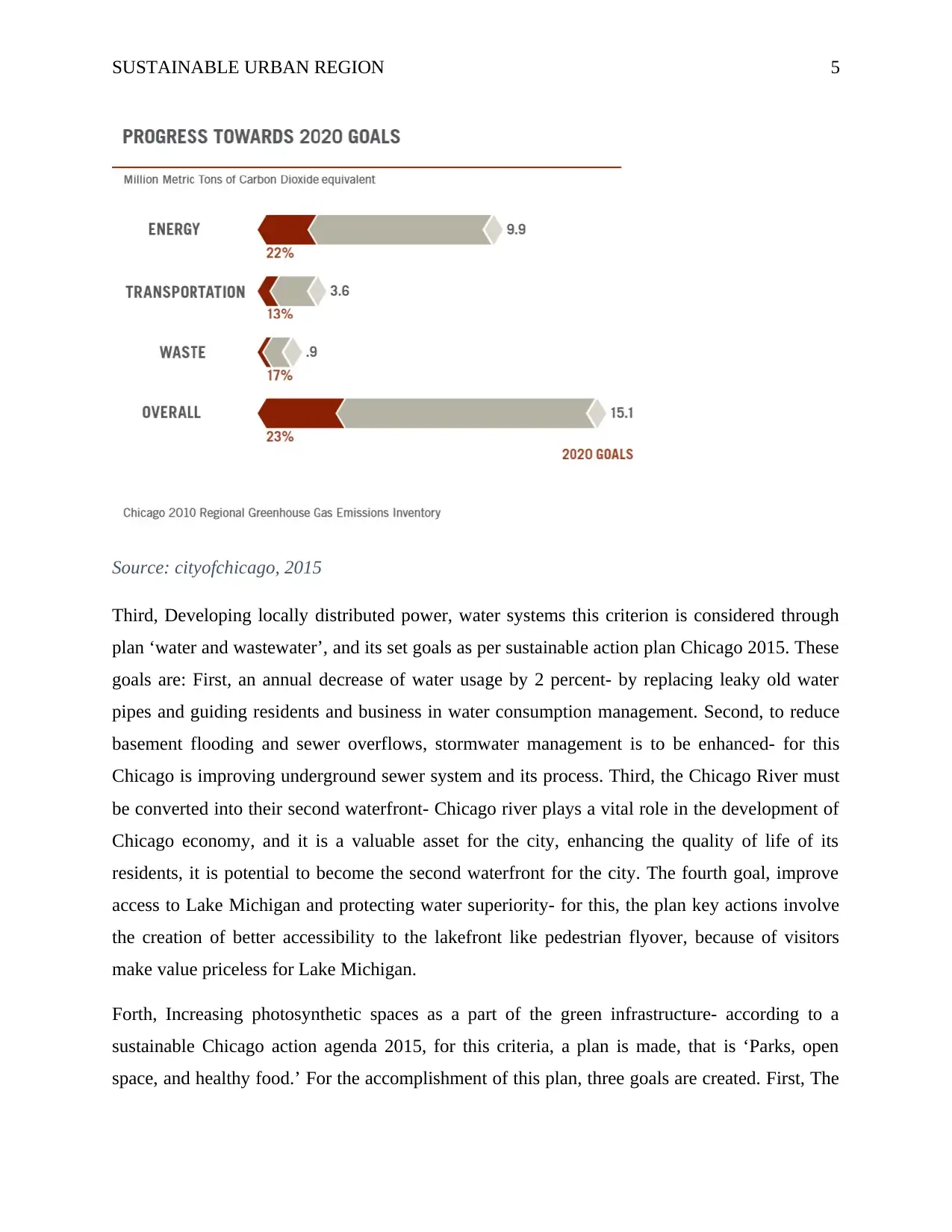
SUSTAINABLE URBAN REGION 5
Source: cityofchicago, 2015
Third, Developing locally distributed power, water systems this criterion is considered through
plan ‘water and wastewater’, and its set goals as per sustainable action plan Chicago 2015. These
goals are: First, an annual decrease of water usage by 2 percent- by replacing leaky old water
pipes and guiding residents and business in water consumption management. Second, to reduce
basement flooding and sewer overflows, stormwater management is to be enhanced- for this
Chicago is improving underground sewer system and its process. Third, the Chicago River must
be converted into their second waterfront- Chicago river plays a vital role in the development of
Chicago economy, and it is a valuable asset for the city, enhancing the quality of life of its
residents, it is potential to become the second waterfront for the city. The fourth goal, improve
access to Lake Michigan and protecting water superiority- for this, the plan key actions involve
the creation of better accessibility to the lakefront like pedestrian flyover, because of visitors
make value priceless for Lake Michigan.
Forth, Increasing photosynthetic spaces as a part of the green infrastructure- according to a
sustainable Chicago action agenda 2015, for this criteria, a plan is made, that is ‘Parks, open
space, and healthy food.’ For the accomplishment of this plan, three goals are created. First, The
Source: cityofchicago, 2015
Third, Developing locally distributed power, water systems this criterion is considered through
plan ‘water and wastewater’, and its set goals as per sustainable action plan Chicago 2015. These
goals are: First, an annual decrease of water usage by 2 percent- by replacing leaky old water
pipes and guiding residents and business in water consumption management. Second, to reduce
basement flooding and sewer overflows, stormwater management is to be enhanced- for this
Chicago is improving underground sewer system and its process. Third, the Chicago River must
be converted into their second waterfront- Chicago river plays a vital role in the development of
Chicago economy, and it is a valuable asset for the city, enhancing the quality of life of its
residents, it is potential to become the second waterfront for the city. The fourth goal, improve
access to Lake Michigan and protecting water superiority- for this, the plan key actions involve
the creation of better accessibility to the lakefront like pedestrian flyover, because of visitors
make value priceless for Lake Michigan.
Forth, Increasing photosynthetic spaces as a part of the green infrastructure- according to a
sustainable Chicago action agenda 2015, for this criteria, a plan is made, that is ‘Parks, open
space, and healthy food.’ For the accomplishment of this plan, three goals are created. First, The
⊘ This is a preview!⊘
Do you want full access?
Subscribe today to unlock all pages.

Trusted by 1+ million students worldwide

SUSTAINABLE URBAN REGION 6
rise in the number of parks and public spaces accessible for residents- for this the city will invest
in new public spaces and enhance innovation to generate open active lanes. Second, availability
of healthy food locally and increasing more variety and options for it in the neighborhood-
around 400,000 residents lack this access nearby, the city will create innovative solutions for the
availability of healthy food varieties within convenient area nearby. Third, increase and
protection of Chicago's biodiversity and natural assets- for this the city will create a protective
habitat for birds and other species to live, in the Calumet region habitat restoration would be
driven.
Fifth, Improving the eco-efficiency- according to Chicago sustainable plan, one of the
considerable categories is ‘Energy Efficiency and clean energy.’ Major goals for this plan
includes: first goal, improving citywide energy efficiency by five percent, for this key actions
considered are support installation of smart meters in households and business in Chicago; also
support improvements in energy efficiency by 20 % in business and homes through Retrofit and
LEED-certified buildings are doubled in number (cityofchicago, 2018). The second goal, in
municipal buildings overall energy efficiency, is to be improved by ten percent. For this, key
actions are energy reduction of 20%by targeting 10 million sq. feet of municipal buildings;
tracking and report of energy consumption (chicagoclimateaction, 2018).
Sixth, increase the sense of place- regarding this criterion sustainable Chicago action agenda
2015 has not included any specific plan. Although some goals regarding the availability of local
food, and exploring local renewable resources options are set to accomplish within other plans.
Seventh, Developing sustainable transport- according to a sustainable plan of Chicago, the goals
to be achieved for this purpose are: First goal, Increase in average of regular transit ridership, for
this goal accomplishment key actions include: Whole renewal of 100 train locations with work
concentrating on painting, lighting, waterproofing, and masonry ensuring they are “dry, safe,
and bright.” The second goal, around transit stations transit-oriented development, would be
accelerated. Third, create Chicago the most bike and pedestrian pleasant city. Forth, hasten high-
speed passenger rail plans and increase freight movement. Fifth, at Chicago's airport
sustainability leadership is advanced. Sixth, to progress vehicle efficiency infrastructure, is to be
strengthened- for this traffic signal timings for buses and cars must be reduced, electronic vehicle
charging stations to be install, development of fuel infrastructure with ‘Chicago Area Clean
rise in the number of parks and public spaces accessible for residents- for this the city will invest
in new public spaces and enhance innovation to generate open active lanes. Second, availability
of healthy food locally and increasing more variety and options for it in the neighborhood-
around 400,000 residents lack this access nearby, the city will create innovative solutions for the
availability of healthy food varieties within convenient area nearby. Third, increase and
protection of Chicago's biodiversity and natural assets- for this the city will create a protective
habitat for birds and other species to live, in the Calumet region habitat restoration would be
driven.
Fifth, Improving the eco-efficiency- according to Chicago sustainable plan, one of the
considerable categories is ‘Energy Efficiency and clean energy.’ Major goals for this plan
includes: first goal, improving citywide energy efficiency by five percent, for this key actions
considered are support installation of smart meters in households and business in Chicago; also
support improvements in energy efficiency by 20 % in business and homes through Retrofit and
LEED-certified buildings are doubled in number (cityofchicago, 2018). The second goal, in
municipal buildings overall energy efficiency, is to be improved by ten percent. For this, key
actions are energy reduction of 20%by targeting 10 million sq. feet of municipal buildings;
tracking and report of energy consumption (chicagoclimateaction, 2018).
Sixth, increase the sense of place- regarding this criterion sustainable Chicago action agenda
2015 has not included any specific plan. Although some goals regarding the availability of local
food, and exploring local renewable resources options are set to accomplish within other plans.
Seventh, Developing sustainable transport- according to a sustainable plan of Chicago, the goals
to be achieved for this purpose are: First goal, Increase in average of regular transit ridership, for
this goal accomplishment key actions include: Whole renewal of 100 train locations with work
concentrating on painting, lighting, waterproofing, and masonry ensuring they are “dry, safe,
and bright.” The second goal, around transit stations transit-oriented development, would be
accelerated. Third, create Chicago the most bike and pedestrian pleasant city. Forth, hasten high-
speed passenger rail plans and increase freight movement. Fifth, at Chicago's airport
sustainability leadership is advanced. Sixth, to progress vehicle efficiency infrastructure, is to be
strengthened- for this traffic signal timings for buses and cars must be reduced, electronic vehicle
charging stations to be install, development of fuel infrastructure with ‘Chicago Area Clean
Paraphrase This Document
Need a fresh take? Get an instant paraphrase of this document with our AI Paraphraser
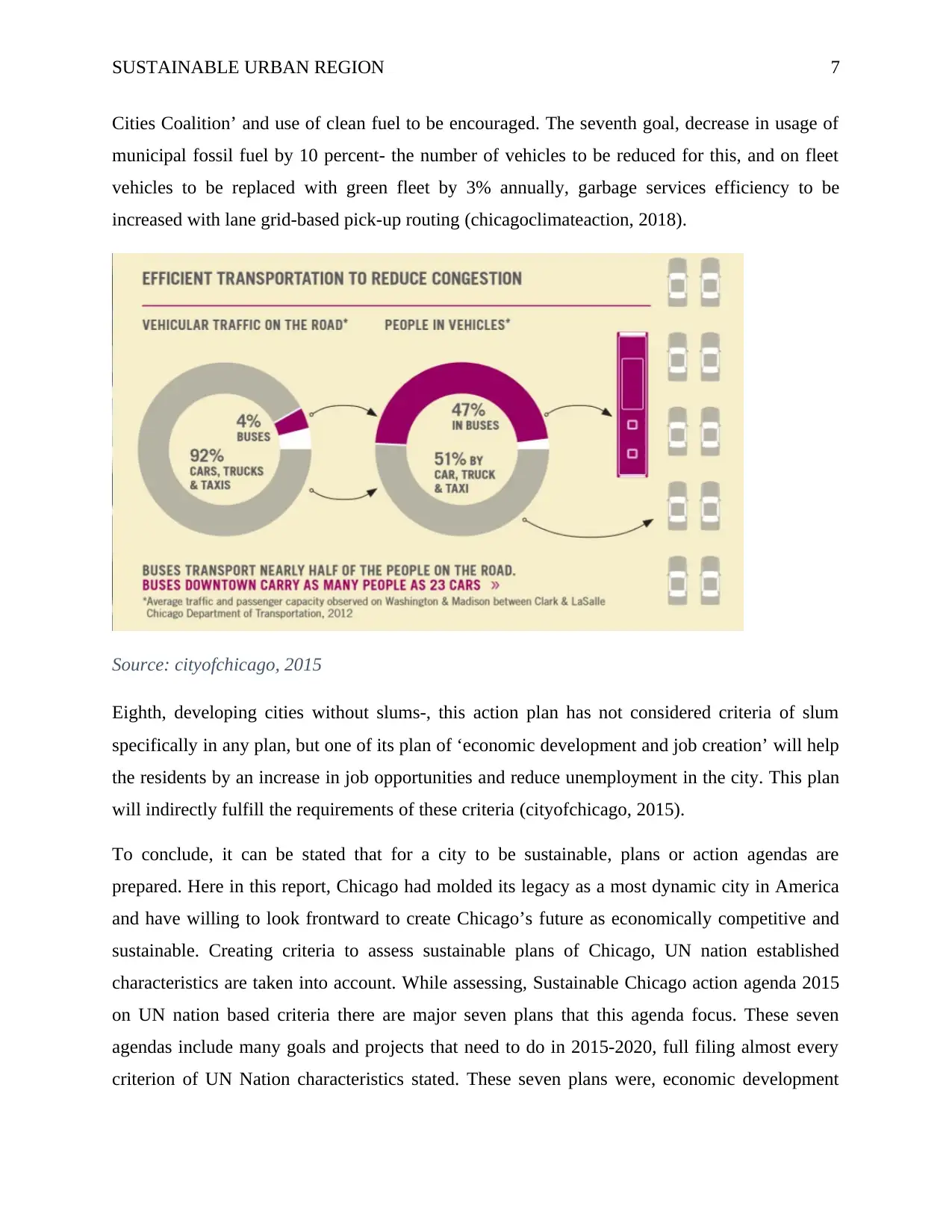
SUSTAINABLE URBAN REGION 7
Cities Coalition’ and use of clean fuel to be encouraged. The seventh goal, decrease in usage of
municipal fossil fuel by 10 percent- the number of vehicles to be reduced for this, and on fleet
vehicles to be replaced with green fleet by 3% annually, garbage services efficiency to be
increased with lane grid-based pick-up routing (chicagoclimateaction, 2018).
Source: cityofchicago, 2015
Eighth, developing cities without slums-, this action plan has not considered criteria of slum
specifically in any plan, but one of its plan of ‘economic development and job creation’ will help
the residents by an increase in job opportunities and reduce unemployment in the city. This plan
will indirectly fulfill the requirements of these criteria (cityofchicago, 2015).
To conclude, it can be stated that for a city to be sustainable, plans or action agendas are
prepared. Here in this report, Chicago had molded its legacy as a most dynamic city in America
and have willing to look frontward to create Chicago’s future as economically competitive and
sustainable. Creating criteria to assess sustainable plans of Chicago, UN nation established
characteristics are taken into account. While assessing, Sustainable Chicago action agenda 2015
on UN nation based criteria there are major seven plans that this agenda focus. These seven
agendas include many goals and projects that need to do in 2015-2020, full filing almost every
criterion of UN Nation characteristics stated. These seven plans were, economic development
Cities Coalition’ and use of clean fuel to be encouraged. The seventh goal, decrease in usage of
municipal fossil fuel by 10 percent- the number of vehicles to be reduced for this, and on fleet
vehicles to be replaced with green fleet by 3% annually, garbage services efficiency to be
increased with lane grid-based pick-up routing (chicagoclimateaction, 2018).
Source: cityofchicago, 2015
Eighth, developing cities without slums-, this action plan has not considered criteria of slum
specifically in any plan, but one of its plan of ‘economic development and job creation’ will help
the residents by an increase in job opportunities and reduce unemployment in the city. This plan
will indirectly fulfill the requirements of these criteria (cityofchicago, 2015).
To conclude, it can be stated that for a city to be sustainable, plans or action agendas are
prepared. Here in this report, Chicago had molded its legacy as a most dynamic city in America
and have willing to look frontward to create Chicago’s future as economically competitive and
sustainable. Creating criteria to assess sustainable plans of Chicago, UN nation established
characteristics are taken into account. While assessing, Sustainable Chicago action agenda 2015
on UN nation based criteria there are major seven plans that this agenda focus. These seven
agendas include many goals and projects that need to do in 2015-2020, full filing almost every
criterion of UN Nation characteristics stated. These seven plans were, economic development

SUSTAINABLE URBAN REGION 8
and job creation; transportation options; climate change; water and wastewater; energy efficiency
and clean energy; parks, open space and healthy food; waste and recycling.
and job creation; transportation options; climate change; water and wastewater; energy efficiency
and clean energy; parks, open space and healthy food; waste and recycling.
⊘ This is a preview!⊘
Do you want full access?
Subscribe today to unlock all pages.

Trusted by 1+ million students worldwide
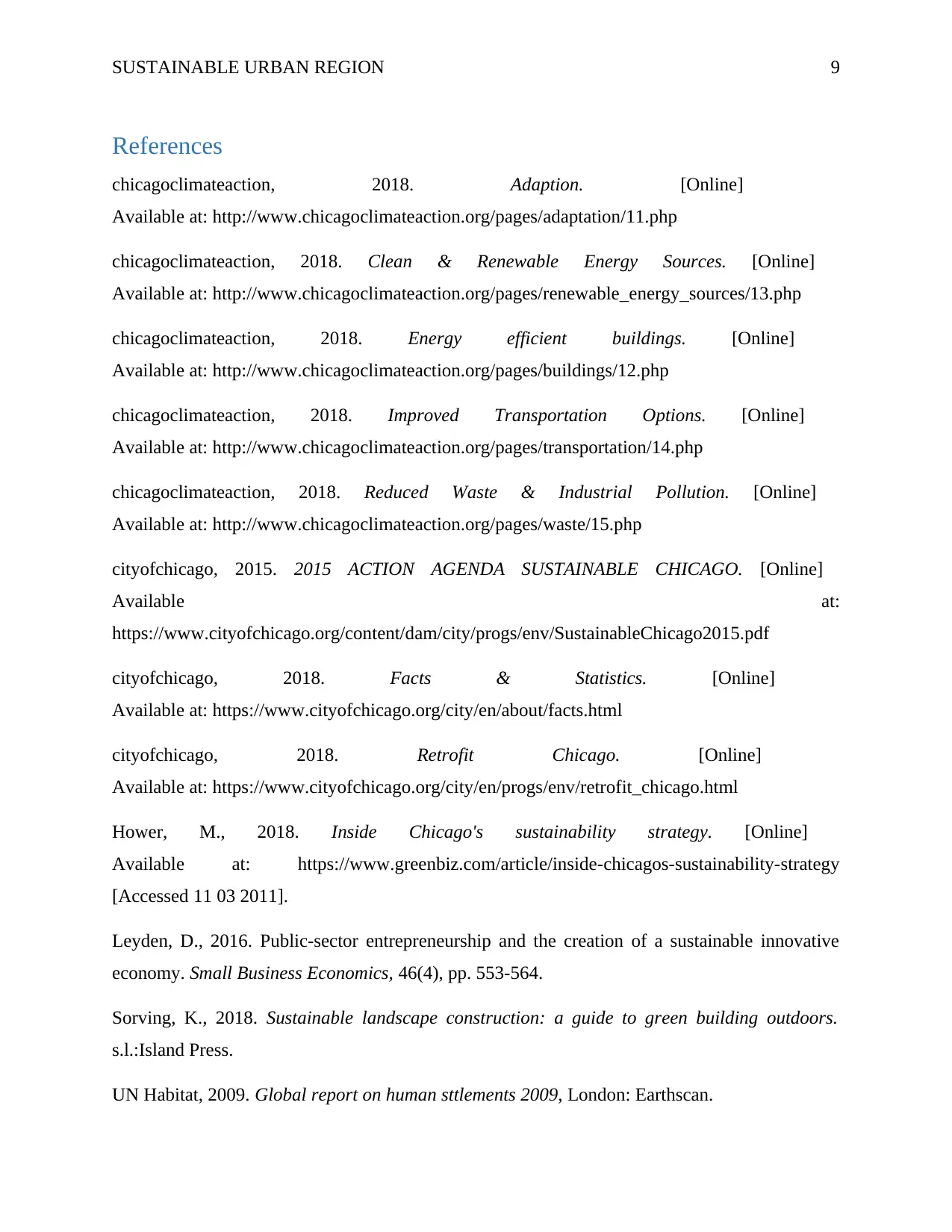
SUSTAINABLE URBAN REGION 9
References
chicagoclimateaction, 2018. Adaption. [Online]
Available at: http://www.chicagoclimateaction.org/pages/adaptation/11.php
chicagoclimateaction, 2018. Clean & Renewable Energy Sources. [Online]
Available at: http://www.chicagoclimateaction.org/pages/renewable_energy_sources/13.php
chicagoclimateaction, 2018. Energy efficient buildings. [Online]
Available at: http://www.chicagoclimateaction.org/pages/buildings/12.php
chicagoclimateaction, 2018. Improved Transportation Options. [Online]
Available at: http://www.chicagoclimateaction.org/pages/transportation/14.php
chicagoclimateaction, 2018. Reduced Waste & Industrial Pollution. [Online]
Available at: http://www.chicagoclimateaction.org/pages/waste/15.php
cityofchicago, 2015. 2015 ACTION AGENDA SUSTAINABLE CHICAGO. [Online]
Available at:
https://www.cityofchicago.org/content/dam/city/progs/env/SustainableChicago2015.pdf
cityofchicago, 2018. Facts & Statistics. [Online]
Available at: https://www.cityofchicago.org/city/en/about/facts.html
cityofchicago, 2018. Retrofit Chicago. [Online]
Available at: https://www.cityofchicago.org/city/en/progs/env/retrofit_chicago.html
Hower, M., 2018. Inside Chicago's sustainability strategy. [Online]
Available at: https://www.greenbiz.com/article/inside-chicagos-sustainability-strategy
[Accessed 11 03 2011].
Leyden, D., 2016. Public-sector entrepreneurship and the creation of a sustainable innovative
economy. Small Business Economics, 46(4), pp. 553-564.
Sorving, K., 2018. Sustainable landscape construction: a guide to green building outdoors.
s.l.:Island Press.
UN Habitat, 2009. Global report on human sttlements 2009, London: Earthscan.
References
chicagoclimateaction, 2018. Adaption. [Online]
Available at: http://www.chicagoclimateaction.org/pages/adaptation/11.php
chicagoclimateaction, 2018. Clean & Renewable Energy Sources. [Online]
Available at: http://www.chicagoclimateaction.org/pages/renewable_energy_sources/13.php
chicagoclimateaction, 2018. Energy efficient buildings. [Online]
Available at: http://www.chicagoclimateaction.org/pages/buildings/12.php
chicagoclimateaction, 2018. Improved Transportation Options. [Online]
Available at: http://www.chicagoclimateaction.org/pages/transportation/14.php
chicagoclimateaction, 2018. Reduced Waste & Industrial Pollution. [Online]
Available at: http://www.chicagoclimateaction.org/pages/waste/15.php
cityofchicago, 2015. 2015 ACTION AGENDA SUSTAINABLE CHICAGO. [Online]
Available at:
https://www.cityofchicago.org/content/dam/city/progs/env/SustainableChicago2015.pdf
cityofchicago, 2018. Facts & Statistics. [Online]
Available at: https://www.cityofchicago.org/city/en/about/facts.html
cityofchicago, 2018. Retrofit Chicago. [Online]
Available at: https://www.cityofchicago.org/city/en/progs/env/retrofit_chicago.html
Hower, M., 2018. Inside Chicago's sustainability strategy. [Online]
Available at: https://www.greenbiz.com/article/inside-chicagos-sustainability-strategy
[Accessed 11 03 2011].
Leyden, D., 2016. Public-sector entrepreneurship and the creation of a sustainable innovative
economy. Small Business Economics, 46(4), pp. 553-564.
Sorving, K., 2018. Sustainable landscape construction: a guide to green building outdoors.
s.l.:Island Press.
UN Habitat, 2009. Global report on human sttlements 2009, London: Earthscan.
1 out of 10
Related Documents
Your All-in-One AI-Powered Toolkit for Academic Success.
+13062052269
info@desklib.com
Available 24*7 on WhatsApp / Email
![[object Object]](/_next/static/media/star-bottom.7253800d.svg)
Unlock your academic potential
Copyright © 2020–2025 A2Z Services. All Rights Reserved. Developed and managed by ZUCOL.





